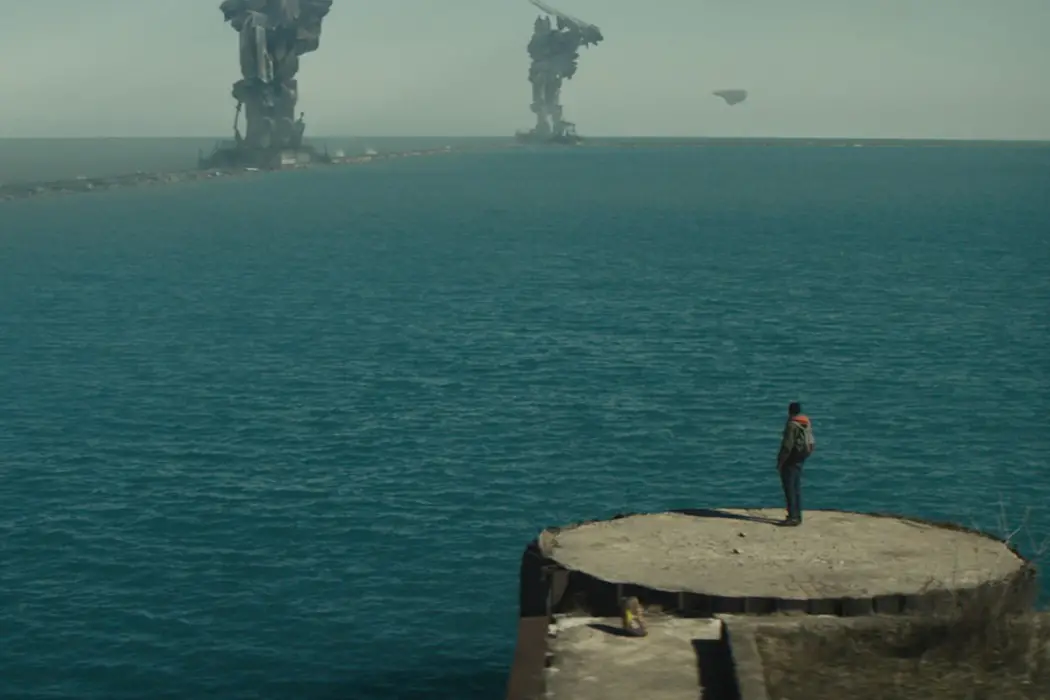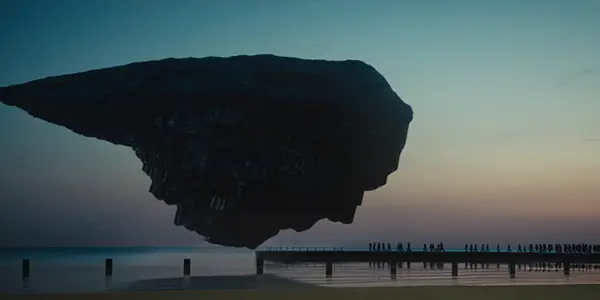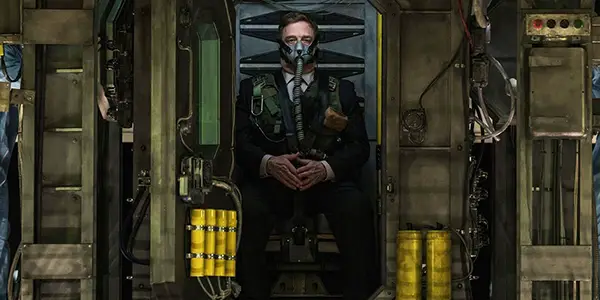CAPTIVE STATE: A Far From Captivating Alien Invasion Sci-Fi

David is a film aficionado from Colchester, Connecticut. He enjoys…
Films that deal with surveillance and paranoia on a massive scale have become ever-prominent in recent years, especially since that trend is on the rise within society in general. Typically, they have been used within sci-fi dystopian films, a genre that is suitable for adequately addressing such concerns.
Captive State contains many elements of this, delving into a world oppressed by an invading alien civilization. What it is lacking, though, is a compelling narrative or characters to hold it all together.
Aftermath of an Invasion
It has been ten years since aliens took over Earth. Through the perspective of the young Gabriel Drummond (Ashton Sanders), we glimpse what life is like now. Though the aliens themselves are little-seen, having been relocated to an underground settlement, they keep a watchful eye on the humans above, both through implants that are inserted into every person’s neck that can track their movements and through the recruitment of a human oppressive government, whose job it is to hunt down and stop any harboring resentment.
When we first see Gabriel, he is attempting to join the rebellion against the aliens, led by a group fittingly called Phoenix. Along the way, he is repeatedly stopped in his tracks by Officer William Mulligan (John Goodman), who is looking to recruit Gabriel as a mole to destroy Phoenix from within.

Considering it’s set in the aftermath of an alien invasion as opposed to the beginnings of one, Captive State starts in a different stage than many thrillers of this nature. As a viewer, you have to put the pieces together while the film slowly unfolds. Admittedly, I did appreciate this slightly altered perspective, especially since the film also doesn’t overuse the aliens, choosing to instead have them as working behind the scenes, and slowly building up their eventual frightening appearances.
Instead, Captive State delves much more into the inner workings of this paranoia-filled world, showing both how the government is able to have a window into our every movement through heightened surveillance, and also how people have turned on each other and even embraced the alien invaders, since they believe that the oppressive force has saved us from our own destruction. It’s here that the film feels most relevant, as it hearkens back to oppressive regimes and their use of surveillance and propaganda, from North Korea, Russia, China, and even some of the rising paranoia within the United States. Fittingly, the film even takes place in Chicago, a place known for its heightened levels of crime.
Uninspired Production
Where the film’s ideas feel relevant, though, it’s their presentation that feels the most uninspired. The world of Captive State appears muted, hazy, overcast – essentially, it’s exactly what you would expect to see in a film of this nature. It’s understandable that the world would appear in such a way after 10 years of being oppressed by an alien civilization, yet it just doesn’t make for compelling cinema all the same. This type of dystopia has been featured in numerous films before, and often much more dynamically presented.

Such an aspect wouldn’t be as frustrating if it wasn’t for the fact that Rupert Wyatt was behind the film, who in 2011 directed Rise of the Planet of the Apes, a film that served as a successful jumpstart to the new Apes trilogy. Here, he’s working in decidedly more familiar territory, which might have worked to his disadvantage, and the film as written doesn’t attempt to break out of the trappings of its generic “rise up” story. The pacing throughout is similarly uneven, with the film lazily maneuvering from one setpiece to the next.
There is one scene, however, that shows the potential that Captive State could’ve had. Here, the members of Phoenix are preparing for an attack, and in short, quickly-edited clips, it shows the preparation in advance, the buildup, and the actual incident itself. Its pulsating energy, accompanied by a techno-inspired score by Rob Simonsen, is enough to keep you on the edge of your seat. That is, until the film settles back into its lethargic humdrum, and the boredom once again starts to sink in.
Lack of Character Development
The production design and special effects of Captive State wouldn’t be as off-putting if the film was populated with characters that had any semblance of personality. John Goodman‘s stoically effective Officer Mulligan towers over nearly all of the people that make up Phoenix, which includes the likes of Machine Gun Kelly, Alan Ruck, and rising star Jonathan Majors. With little development, the film haphazardly chews the characters up and spits them out, giving us little time to care about what eventually happens to them. Also, it should be a crime to underuse Vera Farmiga in the way that this film does.

The one exception here is likely Ashton Sanders’ Gabriel, with the actor bringing charismatic spirit to the role, yet even his character is often pushed to the background, without getting too much of a chance to shine by the conclusion of the film. He’s thankfully used more than in last year’s The Equalizer 2, but one can’t help but feel that Sanders hasn’t yet been given a role fitting of his talent since 2016’s Moonlight.
Captive State: Conclusion
With a premise filled with potential and talent both in front of and behind the screen, Captive State is an unfortunate disappointment. It’s not necessarily a huge misstep for all involved, it’s more that, despite everyone’s involvement, nothing more remarkable came out of it. Yet, with so many original sci-fis currently populating our cinematic landscape, there are bound to be some, like Captive State, that get pushed to the sidelines.
What are your thoughts on Captive State? Are you a fan of alien invasion thrillers? Tell us your thoughts in the comments below!
Captive State was released in the U.S. on March 15, 2019 and will be released in the UK on March 29. For all international release dates, click here.
Does content like this matter to you?
Become a Member and support film journalism. Unlock access to all of Film Inquiry`s great articles. Join a community of like-minded readers who are passionate about cinema - get access to our private members Network, give back to independent filmmakers, and more.
David is a film aficionado from Colchester, Connecticut. He enjoys writing, reading, analyzing, and of course, watching movies. His favorite genres are westerns, crime dramas, horror, and sci-fis. He also enjoys binge-watching TV shows on Netflix.













